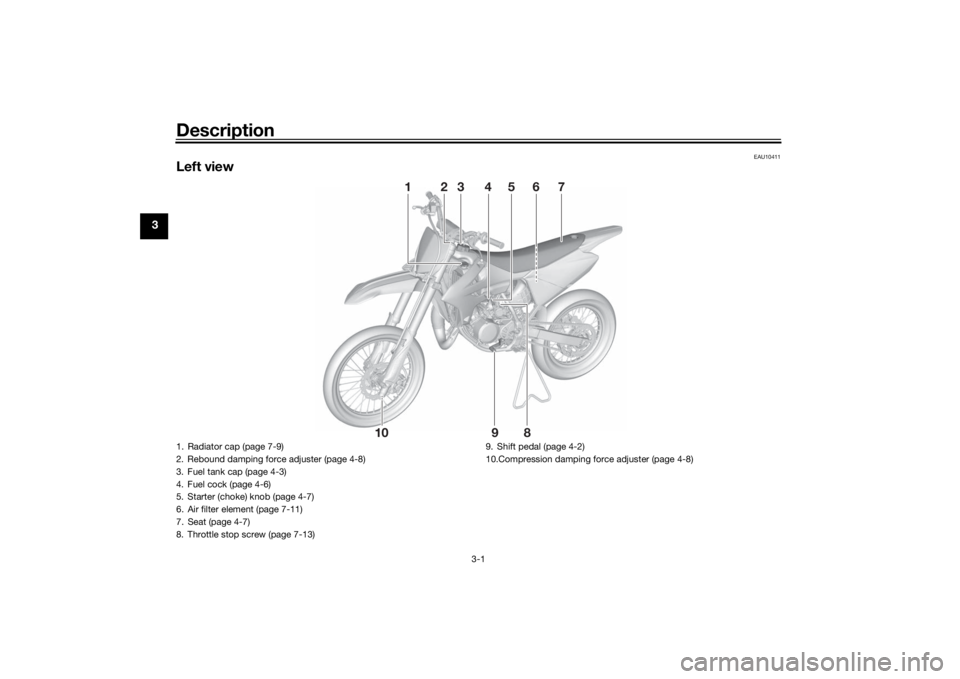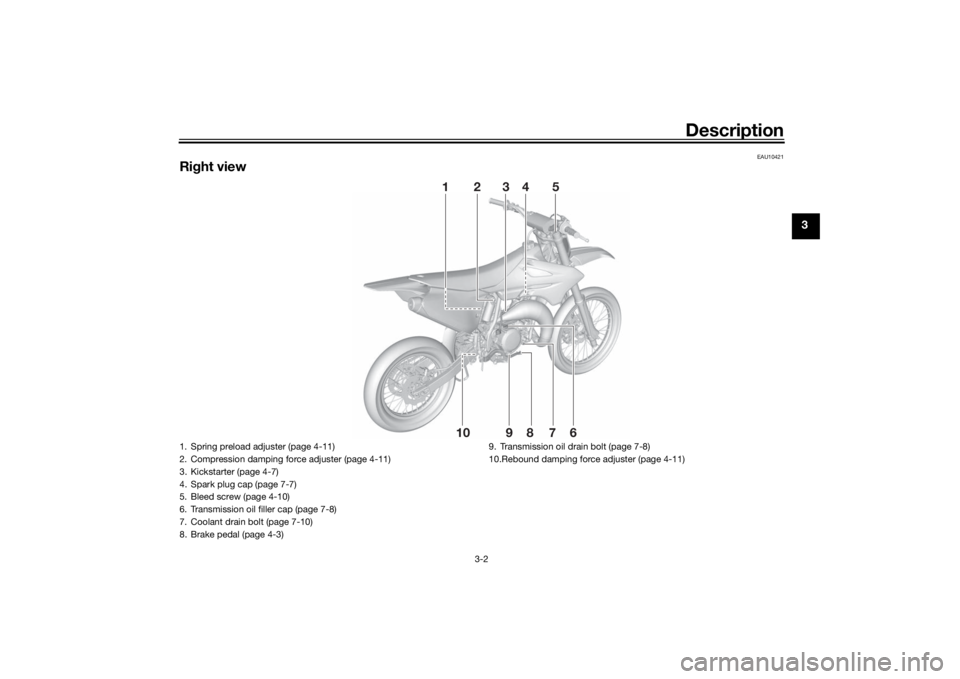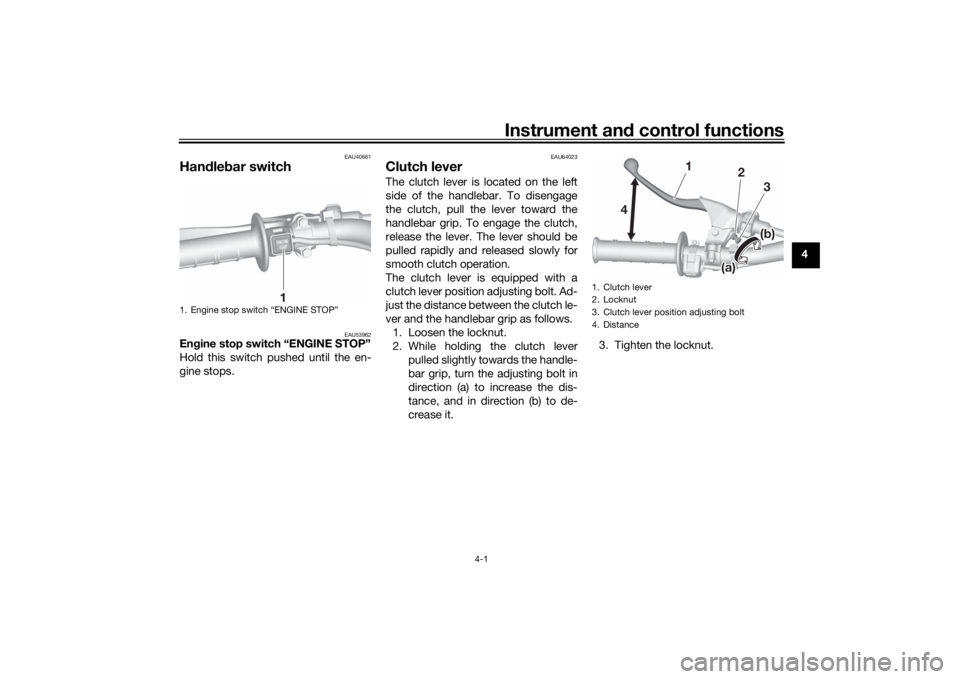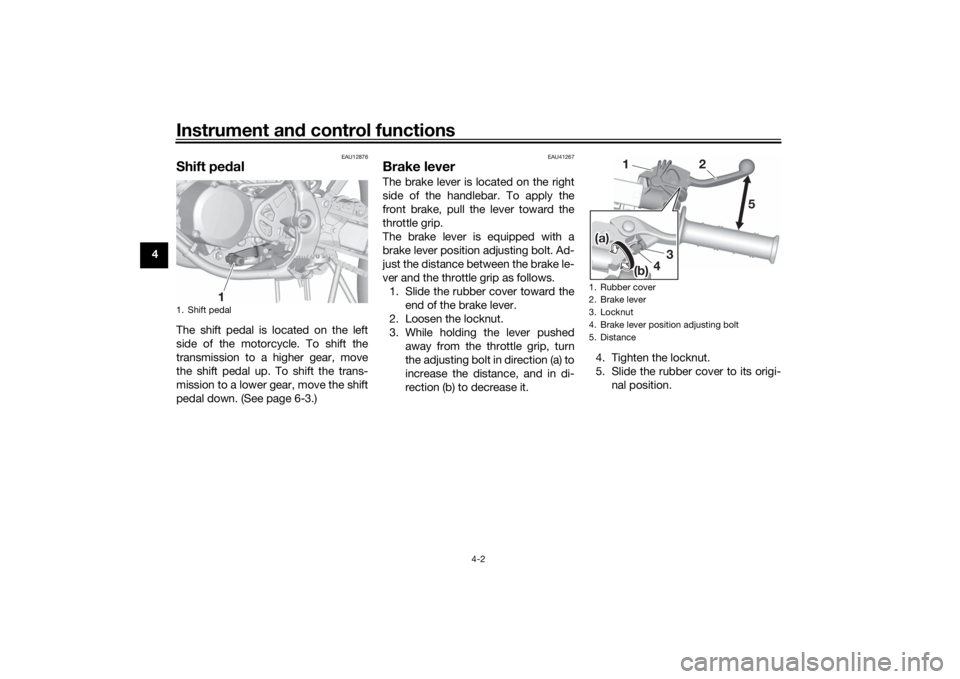YAMAHA YZ85 2022 Owner's Manual
Manufacturer: YAMAHA, Model Year: 2022, Model line: YZ85, Model: YAMAHA YZ85 2022Pages: 90, PDF Size: 2.63 MB
Page 21 of 90

2-1
2
Safety information
EAU4121C
Be a Responsible Owner
As the vehicle’s owner, you are re-
sponsible for the safe and proper oper-
ation of your motorcycle.
Motorcycles are single-track vehicles.
Their safe use and operation are de-
pendent upon the use of proper riding
techniques as well as the expertise of
the operator. Every operator should
know the following requirements be-
fore riding this motorcycle.
He or she should: Obtain thorough instructions from
a competent source on all aspects
of motorcycle operation.
Observe the warnings and mainte-
nance requirements in this Own-
er’s Manual.
Obtain qualified training in safe
and proper riding techniques.
Obtain professional technical ser-
vice as indicated in this Owner’s
Manual and/or when made neces-
sary by mechanical conditions.
Never operate a motorcycle with-
out proper training or instruction.
Take a training course. Beginners
should receive training from a cer-
tified instructor. Contact an autho-
rized motorcycle dealer to find out
about the training courses nearest
you.
Safe Ri din g
Perform the pre-operation checks
each time you use the vehicle to make
sure it is in safe operating condition.
Failure to inspect or maintain the vehi-
cle properly increases the possibility of
an accident or equipment damage.
See page 5-1 for a list of pre-operation
checks. This motorcycle is designed for
off-road use only, therefore, it is il-
legal to operate it on public
streets, roads, or highways, even
a dirt or gravel one. Off-road use
on public lands may be illegal.
Please check local regulations be-
fore riding.
This motorcycle is designed to
carry the operator only. No pas-
sengers.
The failure of motorists to detect
and recognize motorcycles in traf-
fic is the predominating cause of
automobile/motorcycle accidents.
Many accidents have been
caused by an automobile driver
who did not see the motorcycle.
Making yourself conspicuous ap-
pears to be very effective in reduc-
ing the chance of this type of
accident.
Therefore:
• Wear a brightly colored jacket.
• Use extra caution when you are approaching and passing
through intersections, since in-
tersections are the most likely
places for motorcycle accidents
to occur.
• Ride where other motorists can see you. Avoid riding in another
motorist’s blind spot.
• Never maintain a motorcycle without proper knowledge.
Contact an authorized motorcy-
cle dealer to inform you on ba-
sic motorcycle maintenance.
Certain maintenance can only
be carried out by certified staff.
UB4B83E0.book Page 1 Thursday, September 9, 2021 8:47 AM
Page 22 of 90

Safety information
2-2
2
Many accidents involve inexperi-
enced operators.
• Make sure that you are qualified and that you only lend your mo-
torcycle to other qualified oper-
ators.
• Know your skills and limits. Staying within your limits may
help you to avoid an accident.
• We recommend that you prac- tice riding your motorcycle until
you have become thoroughly
familiar with the motorcycle and
all of its controls.
Many accidents have been
caused by error of the motorcycle
operator. A typical error made by
the operator is veering wide on a
turn due to excessive speed or un-
dercornering (insufficient lean an-
gle for the speed). Never travel
faster than warranted by condi-
tions.
Ride cautiously in unfamiliar ar-
eas. You may encounter hidden
obstacles that could cause an ac-
cident.
The posture of the operator is im-
portant for proper control. The op-
erator should keep both hands on
the handlebar and both feet on the
operator footrests during opera-
tion to maintain control of the mo-
torcycle.
Never ride under the influence of
alcohol or other drugs.
Be sure the transmission is in neu-
tral before starting the engine.
Protective Apparel
The majority of fatalities from motorcy-
cle accidents are the result of head in-
juries. The use of a safety helmet is the
single most critical factor in the pre-
vention or reduction of head injuries. Always wear an approved helmet.
Wear a face shield or goggles.
Wind in your unprotected eyes
could contribute to an impairment
of vision that could delay seeing a
hazard.
The use of a jacket, heavy boots,
trousers, gloves, etc., is effective
in preventing or reducing abra-
sions or lacerations.
Never wear loose-fitting clothes,
otherwise they could catch on the
control levers, footrests, or wheels
and cause injury or an accident.
Always wear protective clothing
that covers your legs, ankles, and
feet. The engine or exhaust sys-
tem become very hot during or af-
ter operation and can cause
burns.
Avoi d Car bon Monoxi de Poisonin g
All engine exhaust contains carbon
monoxide, a deadly gas. Breathing
carbon monoxide can cause head-
aches, dizziness, drowsiness, nausea,
confusion, and eventually death.
Carbon Monoxide is a colorless, odor-
less, tasteless gas which may be pres-
ent even if you do not see or smell any
engine exhaust. Deadly levels of car-
bon monoxide can collect rapidly and
you can quickly be overcome and un-
able to save yourself. Also, deadly lev-
els of carbon monoxide can linger for
hours or days in enclosed or poorly
ventilated areas. If you experience any
symptoms of carbon monoxide poi-
UB4B83E0.book Page 2 Thursday, September 9, 2021 8:47 AM
Page 23 of 90

Safety information
2-3
2
soning, leave the area immediately, get
fresh air, and SEEK MEDICAL TREAT-
MENT.
Do not run engine indoors. Even if
you try to ventilate engine exhaust
with fans or open windows and
doors, carbon monoxide can rap-
idly reach dangerous levels.
Do not run engine in poorly venti-
lated or partially enclosed areas
such as barns, garages, or car-
ports.
Do not run engine outdoors where
engine exhaust can be drawn into
a building through openings such
as windows and doors.
Loa din g
Adding accessories to your motorcycle
can adversely affect stability and han-
dling if the weight distribution of the
motorcycle is changed. To avoid the
possibility of an accident, use extreme
caution when adding accessories to
your motorcycle. Use extra care when
riding a motorcycle that has added ac-
cessories. Here are some general
guidelines to follow if adding accesso-
ries to your motorcycle: Operation of an overload
ed vehicle
coul d cause an acci dent.
The weight of the operator must
not exceed 62.0 kg (137 lb).
Accessory weight should be kept
as low and close to the motorcy-
cle as possible. Securely pack
your heaviest items as close to the
center of the vehicle as possible
and make sure to distribute the
weight as evenly as possible on
both sides of the motorcycle to
minimize imbalance or instability.
Shifting weights can create a sud-
den imbalance. Make sure that
accessories are securely attached
to the motorcycle before riding.
Check accessory mounts fre-
quently.
• Properly adjust the suspension for your load (suspension-ad-
justable models only), and
check the condition and pres-
sure of your tires.
• Never attach any large or heavy items to the handlebar, front
fork, or front fender. Genuine Yamaha Accessories
Choosing accessories for your vehicle
is an important decision. Genuine
Yamaha accessories, which are avail-
able only from a Yamaha dealer, have
been designed, tested, and approved
by Yamaha for use on your vehicle.
Many companies with no connection
to Yamaha manufacture parts and ac-
cessories or offer other modifications
for Yamaha vehicles. Yamaha is not in
a position to test the products that
these aftermarket companies produce.
Therefore, Yamaha can neither en-
dorse nor recommend the use of ac-
cessories not sold by Yamaha or
modifications not specifically recom-
mended by Yamaha, even if sold and
installed by a Yamaha dealer.
Aftermarket Parts, Accessories, an
d
Mo difications
While you may find aftermarket prod-
ucts similar in design and quality to
genuine Yamaha accessories, recog-
nize that some aftermarket accesso-
ries or modifications are not suitable
because of potential safety hazards to
you or others. Installing aftermarket
UB4B83E0.book Page 3 Thursday, September 9, 2021 8:47 AM
Page 24 of 90

Safety information
2-4
2products or having other modifications
performed to your vehicle that change
any of the vehicle’s design or operation
characteristics can put you and others
at greater risk of serious injury or
death. You are responsible for injuries
related to changes in the vehicle.
Keep the following guidelines in mind,
as well as those provided under “Load-
ing” when mounting accessories.
Never install accessories that
would impair the performance of
your motorcycle. Carefully inspect
the accessory before using it to
make sure that it does not in any
way reduce ground clearance or
cornering clearance, limit suspen-
sion travel, steering travel or con-
trol operation.
• Accessories fitted to the han- dlebar or the front fork area can
create instability due to improp-
er weight distribution. If acces-
sories are added to the
handlebar or front fork area,
they must be as lightweight as
possible and should be kept to
a minimum. • Bulky or large accessories may
seriously affect the stability of
the motorcycle. Wind may at-
tempt to lift the motorcycle, or
the motorcycle may become
unstable in cross winds.
• Certain accessories can dis- place the operator from his or
her normal riding position. This
improper position limits the
freedom of movement of the
operator and may limit control
ability, therefore, such accesso-
ries are not recommended.
Use caution when adding electri-
cal accessories. If electrical ac-
cessories exceed the capacity of
the motorcycle’s electrical sys-
tem, an electric failure could re-
sult, which could cause a
dangerous loss of lights or engine
power.
Aftermarket Tires an d Rims
The tires and rims that came with your
motorcycle were designed to match
the performance capabilities and to
provide the best combination of han-
dling, braking, and comfort. Other tires, rims, sizes, and combinations
may not be appropriate. Refer to page
7-14 for tire specifications and more in-
formation on replacing your tires.
Transportin
g the Motorcycle
Be sure to observe following instruc-
tions before transporting the motorcy-
cle in another vehicle. Remove all loose items from the
motorcycle.
Check that the fuel cock (if
equipped) is in the “OFF” position
and that there are no fuel leaks.
Point the front wheel straight
ahead on the trailer or in the truck
bed, and choke it in a rail to pre-
vent movement.
Shift the transmission in gear (for
models with a manual transmis-
sion).
Secure the motorcycle with tie-
downs or suitable straps that are
attached to solid parts of the mo-
torcycle, such as the frame or up-
per front fork triple clamp (and not,
for example, to rubber-mounted
handlebars or turn signals, or
parts that could break). Choose
UB4B83E0.book Page 4 Thursday, September 9, 2021 8:47 AM
Page 25 of 90

Safety information
2-5
2
the location for the straps carefully
so the straps will not rub against
painted surfaces during transport.
The suspension should be com-
pressed somewhat by the tie-
downs, if possible, so that the mo-
torcycle will not bounce exces-
sively during transport.
UB4B83E0.book Page 5 Thursday, September 9, 2021 8:47 AM
Page 26 of 90

Description
3-1
3
EAU10411
Left view
10
9
8
3
24
1
5
6
7
1. Radiator cap (page 7-9)
2. Rebound damping force adjuster (page 4-8)
3. Fuel tank cap (page 4-3)
4. Fuel cock (page 4-6)
5. Starter (choke) knob (page 4-7)
6. Air filter element (page 7-11)
7. Seat (page 4-7)
8. Throttle stop screw (page 7-13)9. Shift pedal (page 4-2)
10.Compression damping force adjuster (page 4-8)UB4B83E0.book Page 1 Thursday, September 9, 2021 8:47 AM
Page 27 of 90

Description
3-2
3
EAU10421
Right view
10
8
79
6
21
3
4
5
1. Spring preload adjuster (page 4-11)
2. Compression damping force adjuster (page 4-11)
3. Kickstarter (page 4-7)
4. Spark plug cap (page 7-7)
5. Bleed screw (page 4-10)
6. Transmission oil filler cap (page 7-8)
7. Coolant drain bolt (page 7-10)
8. Brake pedal (page 4-3)
9. Transmission oil drain bolt (page 7-8)
10.Rebound damping force adjuster (page 4-11)
UB4B83E0.book Page 2 Thursday, September 9, 2021 8:47 AM
Page 28 of 90

Description
3-3
3
EAU10431
Controls and instruments
1
2
4
3
1. Clutch lever (page 4-1)
2. Engine stop switch (page 4-1)
3. Brake lever (page 4-2)
4. Throttle grip (page 7-13)UB4B83E0.book Page 3 Thursday, September 9, 2021 8:47 AM
Page 29 of 90

Instrument and control functions
4-1
4
EAU40661
Han dle bar switch
EAU53962
En gine stop switch “ENGINE STOP”
Hold this switch pushed until the en-
gine stops.
EAU64023
Clutch leverThe clutch lever is located on the left
side of the handlebar. To disengage
the clutch, pull the lever toward the
handlebar grip. To engage the clutch,
release the lever. The lever should be
pulled rapidly and released slowly for
smooth clutch operation.
The clutch lever is equipped with a
clutch lever position adjusting bolt. Ad-
just the distance between the clutch le-
ver and the handlebar grip as follows. 1. Loosen the locknut.
2. While holding the clutch lever pulled slightly towards the handle-
bar grip, turn the adjusting bolt in
direction (a) to increase the dis-
tance, and in direction (b) to de-
crease it. 3. Tighten the locknut.
1. Engine stop switch “ENGINE STOP”
1
1. Clutch lever
2. Locknut
3. Clutch lever position adjusting bolt
4. Distance
1
2
4
3(b) (b)
(a) (a) (b)
(a)
UB4B83E0.book Page 1 Thursday, September 9, 2021 8:47 AM
Page 30 of 90

Instrument and control functions
4-2
4
EAU12876
Shift pe dalThe shift pedal is located on the left
side of the motorcycle. To shift the
transmission to a higher gear, move
the shift pedal up. To shift the trans-
mission to a lower gear, move the shift
pedal down. (See page 6-3.)
EAU41267
Brake leverThe brake lever is located on the right
side of the handlebar. To apply the
front brake, pull the lever toward the
throttle grip.
The brake lever is equipped with a
brake lever position adjusting bolt. Ad-
just the distance between the brake le-
ver and the throttle grip as follows.
1. Slide the rubber cover toward the end of the brake lever.
2. Loosen the locknut.
3. While holding the lever pushed away from the throttle grip, turn
the adjusting bolt in direction (a) to
increase the distance, and in di-
rection (b) to decrease it. 4. Tighten the locknut.
5. Slide the rubber cover to its origi-
nal position.
1. Shift pedal
1
1. Rubber cover
2. Brake lever
3. Locknut
4. Brake lever position adjusting bolt
5. Distance
2
5
1
4
(b) (b)
(a) (a)
(b)
(a)
3
UB4B83E0.book Page 2 Thursday, September 9, 2021 8:47 AM